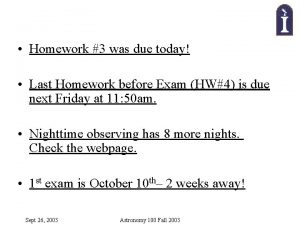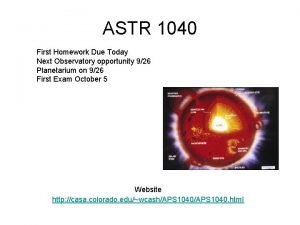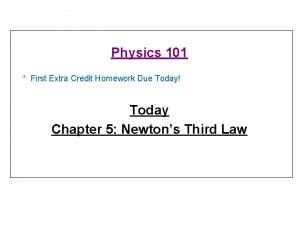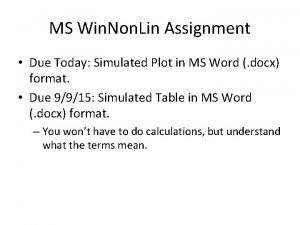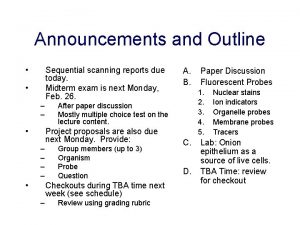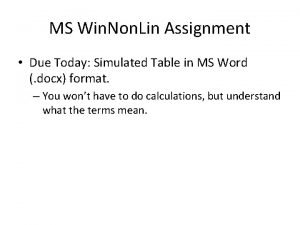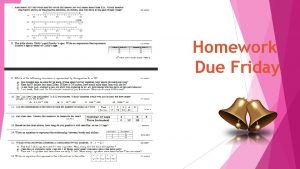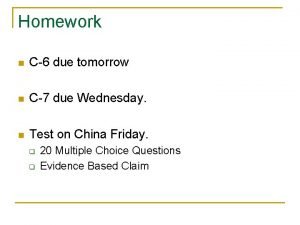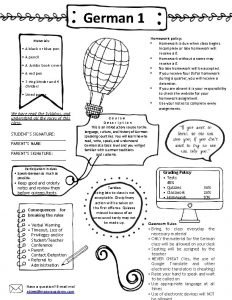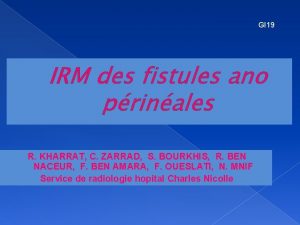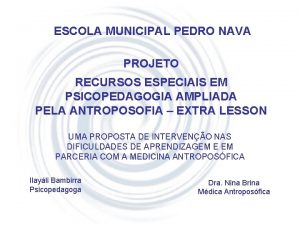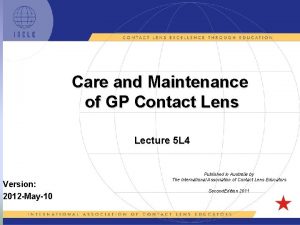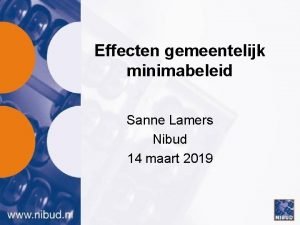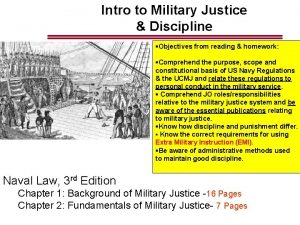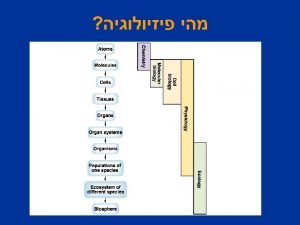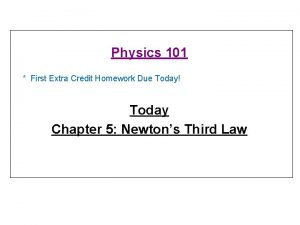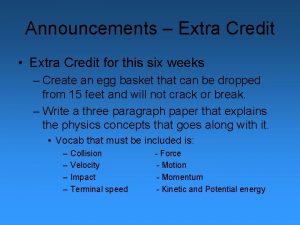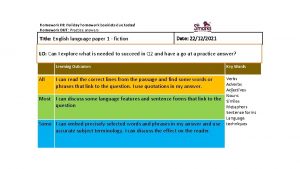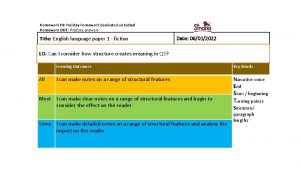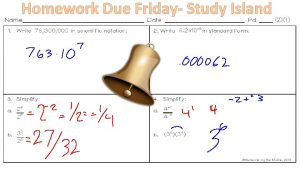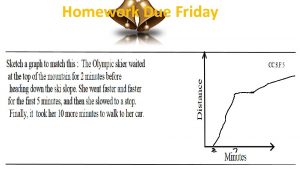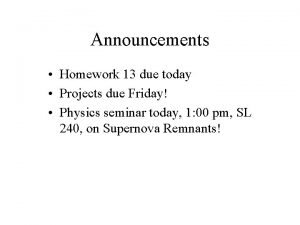Details Homework 4 due Today Extra Credit Homework
































































- Slides: 64

Details • • Homework #4 due Today Extra Credit Homework due Thurs 3/18 Reading, Chapter 7 pages 210 -216 & 220 -224 Final Exam, Tuesday March 23, 8: 00 -10: 00 am – Bring: • • Scantron F-288 ERI-L #2 Pencil Calculator 8 ½ x 11 page of notes • Pick up a registration code for 10 C

T-test and Confidence intervals for difference between two means Small Samples • T statistic and T Test – Standard error – Assumptions – Examples • Confidence intervals for small samples

If one or both of the samples is smaller than 20 • Assume that the population distributions are approximately normal • Also, assume that population variances are equal

Hypothesis Tests for Two Sample Means • Interval Level Dependent Variable • Nominal Level Independent Variable

Small Sample test for two means • • • Assumptions Independent random samples Interval level dependent variable Nominal level independent variable Size of either sample is < 20 • Population variances are equal • Population distributions are normal

T test for the difference between two means

Exact T test if • Variances are assumed equal Estimate a common standard deviation

Estimated Standard Error I hope SPSS calculates this for me !

Sampling distribution of the difference between two means Small Samples • Mean • Standard error • Shape, T Distribution • (Assume equal variances and normal population distributions)

Example, Type of transportation and travel time to work 1990 US Census Motorcycles and Bicycles

Steps • State the assumptions • State the null hypothesis and the research hypothesis and select alpha • Select the appropriate statistical test • Compute the test statistic • Make a decision about the hypothesis and state a conclusion

Hypotheses & Significance Level • Null Hypothesis: Mean commute times by motorcycle are not different from mean commute times by bicycle. • Alternative Hypothesis: Mean commute times by motorcycle are longer than mean commute times by bicycle. • Alpha =. 01

Travel time to work for two means of transportation

Difference between means • Motorcycle – Bicycle

Estimate the standard error • Variances are assumed equal

Estimate the standard error

Estimate the standard error

Estimate the standard error

Compute the test statistic

Compute the test statistic

Sampling distribution of the difference between means

t distribution 0


Degrees of freedom • Population variances assumed equal or both N 1 and N 2 are larger than 20 • Population variances unequal and one or both of N 1 and N 2 is less than 20

Degrees of freedom • Population variances assumed equal or both N 1 and N 2 are larger than 20

Decision about the null hypothesis • The hypothesis is directional, so use a onetailed test • Significance level, alpha =. 01 • Degrees of freedom, df = 38

Alpha =. 01 df=38 Critical value of t is 2. 326

Decision about the null hypothesis • The critical value of t is 2. 326 • The obtained t = 1. 56 Critical value of t= 2. 326 Obtained value of t = 1. 56

P value for obtained t Obtained value of t = 1. 56

One-tailed P value is Between. 1 and. 05 df=38 Obtained value of t = 1. 56

Decision about Hypotheses & Conclusion • Null Hypothesis: Mean commute times by bicycle are not different from mean commute times by motorcycle. • Alternative Hypothesis: Mean commute times by motorcycle are longer than mean commute times by bicycle. Obtained value of t = 1. 56 • Alpha =. 01 P value >. 05 Critical value of t= 2. 326

Conclusion • For a sample of N=18 people, the mean commute time by motorcycle is 16. 44 minutes • For a sample of N=20 people, the mean commute time by bicycle is 11. 86 minutes • The independent samples t-test for this difference is t=1. 56, with d. f. =38 (p>. 05) therefore we cannot reject the null hypothesis that there is no difference in mean commute times between bicycles and motorcycles.

Small Sample Confidence Interval for difference between means

95% CI df=38

T Table df=38 t=2. 021

95% Confidence Interval t=2. 021

95% Confidence Interval From – 1. 36 to 10. 52 t=2. 021

95% Confidence Interval for the difference in commute times between motorcycle and bicycle From – 1. 36 to 10. 52 We can be 95% confident that mean commute times by motorcycle are between 1. 36 minutes shorter and 10. 52 minutes longer than mean commute times by bicycle Notice that the interval includes 0 as a possibility

Another Example • The number of vehicles • In urban and rural areas • Data from 1990 US Census • Use Alpha =. 05 What are the variables here?

Hypotheses • Null Hypothesis: The mean number of vehicles available is not different in rural and urban areas • Alternative Hypothesis: The mean number of vehicles available is different in rural and urban areas


Number of Vehicles

Let SPSS do some of the work !

Let SPSS do some of the work !

Two-tailed P value is Between. 05 and. 1 df=52 A two tailed test Double the probabilities Obtained value of t = +1. 73

Alpha =. 05 ½ of. 05 =. 025 Critical values of t= +/- 1. 96 df=52

Let SPSS do some of the work !

Decision about the null hypothesis Alpha =. 05 Two-tailed P value is Between. 05 and. 1 Critical value of t= -1. 96 Critical value of t= +1. 96 Obtained value of t = +1. 73

Decision about the null hypothesis • Null Hypothesis: The mean number of vehicles available is not different in rural and urban areas Using a. 05 significance level • Alternative mean number Do not. Hypothesis: reject the null. The hypothesis Thereavailable is no significant difference of vehicles is different in rural and between the mean number of vehicles available urban areas in rural and urban areas

95% Confidence Interval for difference between means

95% CI df=52 t=+/- 1. 96

95% Confidence Interval for difference between means t=+/- 1. 96

95% Confidence Interval for difference between means t=+/- 1. 96

95% Confidence Interval for difference between means

95% Confidence Interval for difference between mean number of vehicles in rural and urban areas • We can be 95% confident that the mean number of vehicles in rural areas is ……


95% CI df=38

Estimate the common standard deviation • Variances are assumed equal

Estimate the common standard deviation • Variances are assumed equal

Estimate the common standard deviation • Variances are assumed equal

Hypotheses & Significance Level • Null Hypothesis: Mean commute times by motorcycle are not different from mean commute times by bicycle. • Alternative Hypothesis: Mean commute times by motorcycle are longer than mean commute times by bicycle. • Alpha =. 01

Difference between means • Motorcycle – Bicycle

SPSS output – Independent samples t test

 This can be avoided by giving credit where credit is due.
This can be avoided by giving credit where credit is due. Homework due today
Homework due today Homework
Homework Homework due today
Homework due today Homework due today
Homework due today Black cat analogy
Black cat analogy Astr
Astr Homework due today
Homework due today Extra credit chapter 15
Extra credit chapter 15 Extra credit avance
Extra credit avance Geometry extra credit
Geometry extra credit How to ask for extra credit
How to ask for extra credit Extra credit anime
Extra credit anime How to start email to teacher
How to start email to teacher K5 think central
K5 think central Grammatical signals
Grammatical signals Major and minor supporting sentences adalah
Major and minor supporting sentences adalah Aig life insurance nedbank
Aig life insurance nedbank In todays lesson
In todays lesson Today's lesson or today lesson
Today's lesson or today lesson Meeting objective
Meeting objective Fingerprint galton details
Fingerprint galton details For todays meeting
For todays meeting Today's lesson or today lesson
Today's lesson or today lesson Assignment due today
Assignment due today Reports due today
Reports due today Assignment due today
Assignment due today Central vein liver
Central vein liver Assignment due today
Assignment due today Astr 100 uiuc
Astr 100 uiuc Due piccole sfere identiche sono sospese
Due piccole sfere identiche sono sospese Figura 4 lati
Figura 4 lati Procedural vs substantive due process
Procedural vs substantive due process Grande rhetra
Grande rhetra Fill in the blank. you finish your homework today?
Fill in the blank. you finish your homework today? Homework is due on friday
Homework is due on friday Homework due tomorrow
Homework due tomorrow Homework is due
Homework is due Homework is due on friday
Homework is due on friday Homework oh homework i hate you you stink
Homework oh homework i hate you you stink When she sings her voice is like velvet
When she sings her voice is like velvet Parts of a poem
Parts of a poem Jack prelutsky homework oh homework
Jack prelutsky homework oh homework Jack prelutsky homework oh homework
Jack prelutsky homework oh homework Alitteration definition
Alitteration definition Classification exophtalmie scanner
Classification exophtalmie scanner Res extra commercium
Res extra commercium Fistule extra sphinctérienne
Fistule extra sphinctérienne Extra markup html
Extra markup html Introduction to high voltage technology
Introduction to high voltage technology Extra lesson antroposofia
Extra lesson antroposofia Optikem international
Optikem international Edward syndrome
Edward syndrome Nibud extra vervoerskosten
Nibud extra vervoerskosten Mfl games
Mfl games Discipline
Discipline Chapter 14 human heredity
Chapter 14 human heredity Reciprocal arm rpd
Reciprocal arm rpd Extra cell matrix
Extra cell matrix Montserrat extra
Montserrat extra Leks
Leks Extra ribs
Extra ribs Extra move
Extra move Value matrix
Value matrix Double y syndrome
Double y syndrome




